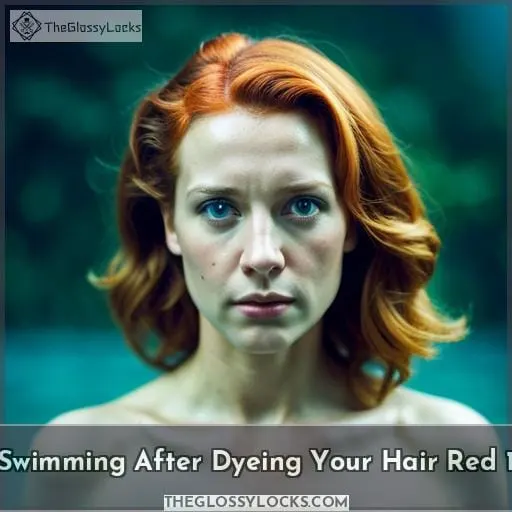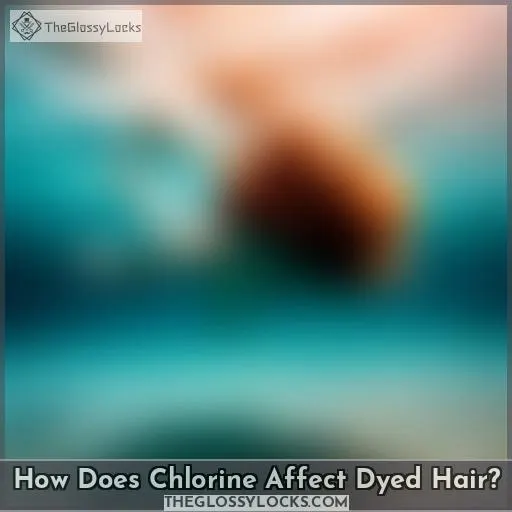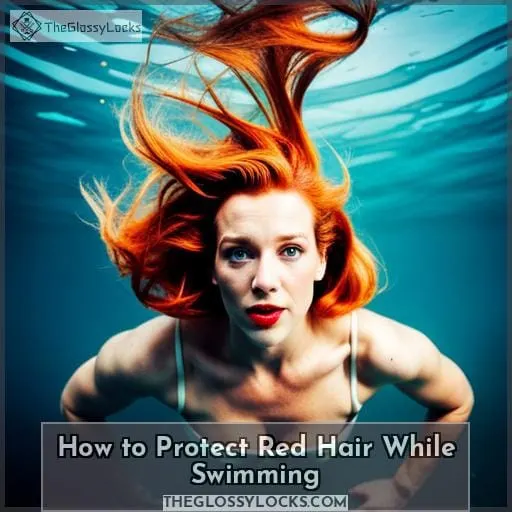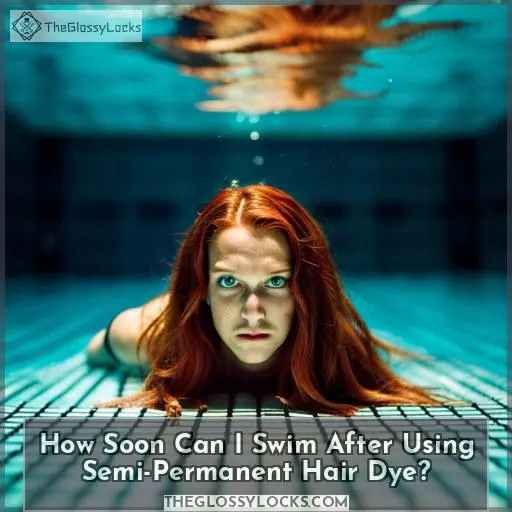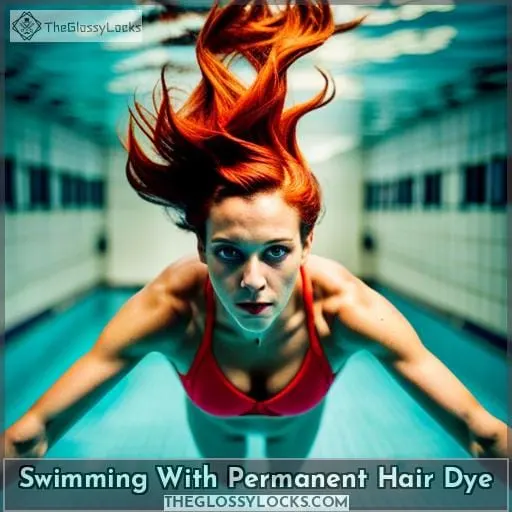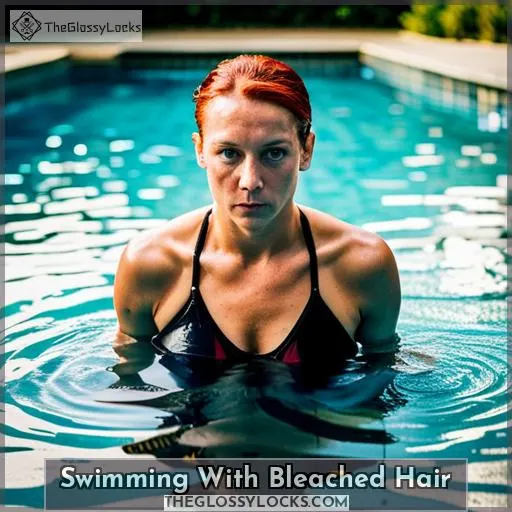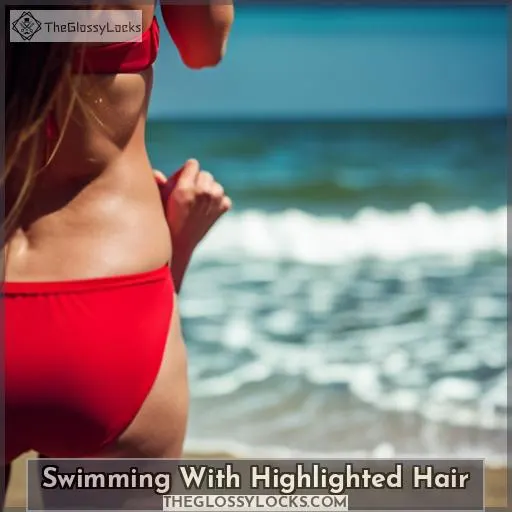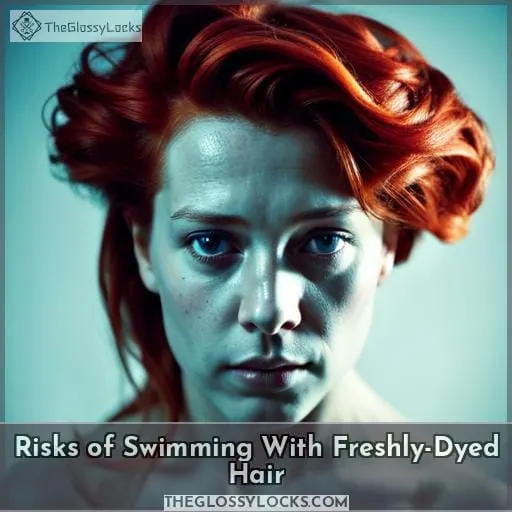This site is supported by our readers. We may earn a commission, at no cost to you, if you purchase through links.
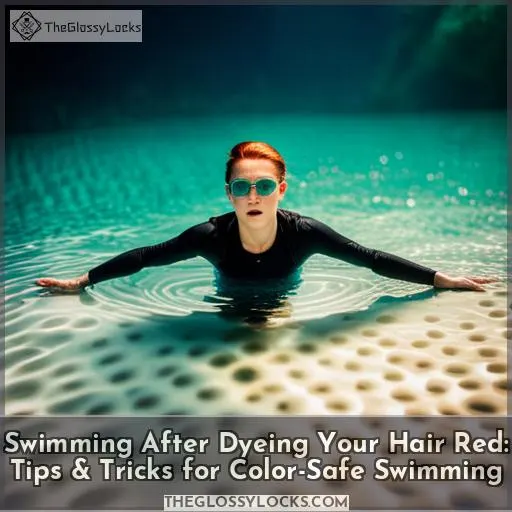 Taking a dip in the pool after dyeing your hair can seem like an intimidating prospect. But fear not – it doesn’t have to be! With the right knowledge and preparation, you can swim with confidence after dyeing your hair red without compromising its color or condition.
Taking a dip in the pool after dyeing your hair can seem like an intimidating prospect. But fear not – it doesn’t have to be! With the right knowledge and preparation, you can swim with confidence after dyeing your hair red without compromising its color or condition.
In this article, we’ll provide tips on how swimming affects dyed and highlighted hair of all colors, from permanent dyes to semi-permanent ones.
Get ready for some knowledgeable advice on swimming safely with freshly dyed locks so you won’t ever need to compromise between vibrant color and fun summer activities again!
Table Of Contents
- Key Takeaways
- Can I Swim After Dyeing My Hair Red?
- How Does Chlorine Affect Dyed Hair?
- How to Protect Red Hair While Swimming
- Can I Swim After Dyeing My Hair Brown?
- How Soon Can I Swim After Using Semi-Permanent Hair Dye?
- Swimming With Permanent Hair Dye
- Swimming With Semi-Permanent Hair Dye
- Swimming With Bleached Hair
- Swimming With Highlighted Hair
- Risks of Swimming With Freshly-Dyed Hair
- Frequently Asked Questions (FAQs)
- Conclusion
Key Takeaways
- Wait a few days after dyeing red hair before swimming to avoid damage from chlorine and saltwater.
- Use a swim cap to protect against color fading and damage to freshly-dyed red hair.
- Apply moisturizing treatments before swimming to minimize the effects of chlorine on red hair.
- Rinse with cold water, then hot water, and wash with mild chelating shampoos to remove chlorine and protect the color of red hair.
Can I Swim After Dyeing My Hair Red?
You should wait a few days before taking a dip in the pool after coloring your locks red, as chlorine can react with the dye and cause irreparable damage. Red hair is particularly susceptible to fading when exposed to swimming pools or saltwater.
The open cuticles of freshly-dyed hair make it more vulnerable to chemical reactions from chlorine and salt water, which can strip away moisture and natural oils leaving your mane dry, dull-looking, and brittle – all signs of damaged tresses! To protect the color you’ve just achieved through permanent or semi-permanent dyeing methods such as highlights or ombre effects, use a protective swim cap before entering any body of water where there may be traces of chlorinated chemicals present.
To further safeguard against color bleeding due to porosity levels in dyed hair strands, apply moisturizing treatments like specialized conditioners meant for colored tresses prior to swimming time.
Once done with enjoying some aquatic activities, rinse off thoroughly using cold running tap water initially, then hot afterwards (but not too hot!), followed by washing once again using mild chelating shampoos specifically designed for swimmers that help restore lost nutrients while clarifying impurities from porous surfaces easily without causing extra damage whatsoever on hues already subjectively affected/diminished by pool potions plus oceanic salts alike.
How Does Chlorine Affect Dyed Hair?
Chlorinating your locks can cause serious damage and unexpected color changes, particularly when you’ve recently treated them with a semi-permanent or permanent dye job. Chlorine reacts with the hydrogen peroxide in hair dyes, causing oxidation and fading of the hair color.
This is especially true for red hues, which are more susceptible to chlorine’s bleaching properties than other colors like blonde, brown, or purple.
Open cuticles from dyeing make it easier for chlorine to enter the strands and wreak havoc on your tresses’ pigmentation!
To protect freshly dyed red hair from chlorinated water:
- Utilize special products designed specifically for colored tresses, such as creams that form a protective barrier over each strand. These help minimize potential damage by proofing against harsh chemicals while providing extra hydration during swimming sessions.
- Apply leave-in conditioners before entering pool waters. These coat each strand evenly so they’re less likely to absorb too much liquid, resulting in an uneven finish post swimsies time!
- Consider investing in swim caps that cover all of your mane. This will provide another layer of protection against chlorine exposure while keeping pesky flyaways outta sight too
It’s also important to take into account the porosity levels within dyed hairs, as those tend to be higher than natural ones due to its over-processed state. Use deep conditioning treatments tailored towards swimmers every now and then, just in case any mineral deposits have made their way inside via oceanic salts, etcetera.
. Doing this should help keep moisture intact, thus preserving both their vibrancy and healthiness quality-wise overall, despite whatever ya decide ta dip into afterwards (if anything at all!).
Lastly, note though, please remember not to let any preconceived ideas fool yah either – even if going for darker shades instead of ‘lightening up’, it still requires adequate wait times before taking the plunge.
How to Protect Red Hair While Swimming
Now that you know the risks associated with swimming after dyeing your hair red, it’s time to learn how to protect your locks from chlorine damage.
Here are some helpful tips on keeping your color looking vibrant and beautiful:
- Use products specifically designed for colored tresses, such as creams that form a protective barrier over each strand.
- Apply leave-in conditioners before entering pool waters or ocean waves. These coat each strand evenly so they’re less likely to absorb too much liquid, resulting in an uneven finish post dip session!
- Invest in good quality swim caps – these will provide another layer of protection against chlorine exposure while keeping pesky flyaways outta sight too
It is also important to take into account the porosity levels within dyed hairs; those tend to be higher than natural ones due to its overprocessed state. Make sure you deep condition regularly (or when needed), especially if taking dips in saltwater which can strip away moisture and natural oils from highlighted hair, leaving them dry and brittle afterwards.
Lastly, even if going for darker shades instead of ‘lightening up’, it still requires adequate wait times before taking the plunge, otherwise risking possible irreversible consequences occurring thereafter unfortunately
Can I Swim After Dyeing My Hair Brown?
Swimming after dyeing your hair brown can be a tricky endeavor, as the chemicals in the dye may react with chlorine and saltwater to cause fading or damage. To protect your locks from potential harm, it’s important to understand hair porosity levels and use moisturizing tips accordingly.
If you’re planning on taking a dip soon after coloring your strands, consider investing in quality hair caps or other protective gear, such as swim goggles, that will keep chlorine-filled waters away from freshly dyed hair.
To preserve color vibrancy for longer periods of time, look for specially formulated products meant specifically for colored hair. These products help form an extra layer over each strand while nourishing them at the same time! And don’t forget about leave-in conditioners either.
Additionally, make sure you rinse off any excess product before entering plain waters too.
Lastly, remember that permanent dyes require more waiting times than semi-permanent ones due to their ability to completely change colors without causing further damage, unlike their counterpart’s weaker pigments, which might get washed away by salty water eventually.
Yet, they still leave behind some kind of hue, even if barely noticeable when compared next to the original shades beforehand.
Therefore, take the necessary precautionary steps prior to diving deep enough, ensuring that whatever protection is available gets applied both inside and outside swimming pool areas alike, thus avoiding possible irreversible consequences occurring thereafter, unfortunately.
How Soon Can I Swim After Using Semi-Permanent Hair Dye?
If you’re eager to take a dip after dyeing your mane, it’s best to wait at least three days before doing so in order to avoid any hair disasters! Semi-permanent dyes coat the hair strands and don’t permanently alter the color of your locks, but can still fade if exposed too soon.
To protect freshly dyed tresses from chlorine or saltwater damage, consider taking these steps:
- Invest in quality protection gear such as swim caps or goggles that will keep away waters filled with chlorine.
- Use specially formulated products for colored hair that form an extra layer over each strand while nourishing them at the same time.
- Apply leave-in conditioners prior to swimming, which coat every single cuticle preventing moisture absorption during swims and protecting from uneven finishes later on down the line!
It is also important to remember that permanent dyes require more waiting times than semi-permanent ones due to their ability to completely change colors without causing further damage.
Furthermore, look out for direct deposit dyes when shopping around; they are usually gentler on freshly dyed tresses compared to other options available nowadays while providing vivid hues all alike – just what we need during summer season heatwaves like these one right here today, huh?! So get ready this holiday season by following a few tips above discussed about caring for our scalps appropriately prior to taking the plunge back there again – safe & soundly thanks to goodness!!
Swimming With Permanent Hair Dye
If you’ve recently dyed your hair red, it’s important to be aware of the effects chlorine can have on permanent hair dye. Chlorine is a bleaching agent and can lighten dyed hair, resulting in uneven color or fading.
To avoid damage when swimming with newly-dyed locks, there are several recommendations that should be followed.
Effects of Chlorine on Permanent Hair Dye
You should be aware that chlorine in swimming pools can react with permanent hair dye, leading to oxidation and color change. To minimize damage, it’s best to use a chlorine-resistant dye specifically formulated for your hair porosity and structure.
Deep conditioning before swimming is also essential, as well as applying a pre-swim conditioner or coconut oil barrier against the bleach agent within pool water.
Permanent hair colors are more likely to fade over time due to the increased use of Olaplex treatments on highlighted strands.
Furthermore, avoid saltwater altogether since it will strip away natural oils from your tresses while making them dry and brittle at the same time – not something we want happening now, do we?!
Lastly, an important tip for all dyed-haired swimmers out there: always remember enough protection gear such as swim caps or goggles so that these precious locks stay safe each summer season around here!
Recommendations for Swimming With Permanent Hair Dye
To protect your newly-dyed red locks, it’s best to wait at least three days before taking a dip.
To ensure the longevity of the vibrant hue, moisturizing tips such as using a specialized hair cream or coconut oil prior to swimming are essential. Hair porosity plays an important role in this matter too. Low porosity hair tends not to absorb much water, while high porosity strands tend to be more vulnerable when exposed directly to chlorine water.
Color depositing dyes may have slightly less effect compared with semi-permanent and permanent ones, but they still require extra care when going for a swim. Pre-swim conditioners also form an effective barrier against bleaching agents found within pool waters.
Lastly, make sure you shampoo your tresses every couple of washing days with high-quality products tailored for natural hair colors like yours.
Swimming With Semi-Permanent Hair Dye
If you’ve recently dyed your hair red using a semi-permanent dye, it’s important to be aware of the interaction between chlorine and the color pigment in your hair. Seawater can also have an effect on semi-permanent dye, so understanding how to protect this color is key for preventing fading or discoloration.
Here are some tips that will help keep your newly dyed locks vibrant while swimming:
- Use specialized products before taking a dip.
- Wait at least 24 hours after dying before entering water.
- Use a swim cap whenever possible.
- Moisturize with coconut oil or conditioner beforehand.
- Rinse off excess product from strands before going in the pool/ocean.
Interaction Between Semi-Permanent Hair Dye and Chlorine
When it comes to semi-permanent hair dye, chlorine in swimming pools can cause fading and unexpected shades. To protect your red locks from the damaging effects of chlorine, there are several protective products available.
Use a specialized pre-swim conditioner or coconut oil to moisturize before hitting the pool. This helps create a barrier against harsh chemicals. Additionally, consider your hair’s porosity when selecting products.
This ensures that pigments of your hair will be protected for longer periods of time without color bleeding or fading due to exposure in water. Lastly, use special hair care products specifically made for colored tresses after every swim session.
Effects of Seawater on Semi-Permanent Hair Dye
Be sure to think twice before taking a dip in the ocean with your newly-dyed red locks, as saltwater can strip moisture and natural oils from hair, causing it to become brittle and dry.
To reduce the risk of color bleeding or fading due to exposure in water, consider hair’s porosity when selecting protective products like pre-swim conditioners or coconut oil.
Investing in the best swim cap will also help protect dyed hair from chlorine or saltwater without compromising style. For colored tresses that need additional protection, use special shampoos specifically made for colored strands.
Tips for Swimming With Semi-Permanent Hair Dye
If you’ve recently dyed your locks, it’s important to remember a few key tips before taking a dip in the pool or ocean. Investing in waterproofing products and color-protecting shampoo can help prevent damage caused by chlorine or saltwater.
Pre-swim conditioning with coconut oil can also create an additional barrier against harsh chemicals while moisturizing the hair at the same time.
Depending on your hair’s porosity, using specialized shampoos specifically made for colored strands may work best as they maintain shine and vibrancy while preserving pigments for longer periods of time! A swim cap will help protect dyed hair from both chlorine and saltwater without compromising style, but don’t forget to rinse out any excess product beforehand so it doesn’t block pores in your scalp, which could lead to more damage down the line!
Lastly, deep conditioning after every session will ensure that moisture levels are properly restored, making sure that all your hard work won’t go in vain!
Swimming With Bleached Hair
If you’ve recently dyed your hair red, bleaching it can leave your locks vulnerable to damage from chlorine and saltwater. Chlorine in swimming pools can strip moisture and natural oils from the strands, while salty ocean water has a tendency to fade color.
To protect your newly colored tresses against these elements while swimming, taking certain precautions is essential for maintaining vibrant hair color.
Impact of Chlorine on Bleached Hair
Swim with caution, as chlorine in swimming pools can cause severe damage to your delicate bleached hair. Even a small amount of chlorine absorption can lead to color fading and dryness.
Understanding the basics of hair porosity is essential when it comes to taking precautions before going for a swim. To protect against chemical reactions between chlorine and dye pigments, it is recommended to deep condition or use pre-swim conditioners, depending on your hair’s porosity level.
If you plan on entering highly chlorinated water often, look into the best hair dye advice available to help protect dyed locks from the damaging effects of pool chemicals.
Always remember that waiting at least three days after coloring is important, no matter what color you choose!
Effects of Salty Water on Bleached Hair
Take heed when venturing into salty water, as it can strip bleached hair of its natural oils and moisture, leaving it brittle and dull. To protect your lightened locks, moisten with treatments before swimming to reduce color fading caused by saltwater’s bleaching agents.
Determine the level of porosity in your hair using a strand test or other methods to choose the right protective creams for different colors.
Avoid daily swims in highly chlorinated pools. Bacteria growth can occur due to warmth combined with chlorine chemicals in enclosed spaces like hot tubs or saunas.
Saltwater will make dyed blonde more transparent on lighter shades while causing dryness that eventually damages strands if not treated properly after swimming.
Precautions for Swimming With Bleached Hair
To protect your freshly bleached locks, it’s important to take the necessary precautions before taking a dip in chlorinated or saltwater. Hair porosity affects how much moisture and oil is retained by each strand, so use deep conditioners and moisturizing products designed for colored hair accordingly.
When swimming in salty water, apply coconut oil first as an extra barrier against color fading caused by its bleaching agents – too much of this can turn blonde hair green!
Chlorine pools are also dangerous; bacteria growth due to warmth combined with chemicals could occur if you swim daily in highly chlorinated areas like hot tubs or saunas.
To avoid dye staining and discoloration from chemical reactions, wait at least 3 days after dying red before submerging yourself into any pool – be sure to rinse off excess dye beforehand too!
With proper protection based on your individual needs and understanding of the environment around you – no matter what color – you’ll have beautiful locks that stay vibrant for years!
Swimming With Highlighted Hair
If you’ve recently dyed your hair red and added highlights, swimming can be a tricky affair. Chlorine in swimming pools can cause the color of highlighted hair to turn green or fade outright, while salty ocean water has the potential to strip moisture from already dry strands.
To protect your newly colored tresses against these elements while swimming, it is recommended that you wait at least three days after dyeing before jumping into any body of water and use deep conditioning treatments afterward to restore any lost moisture.
Chlorine’s Effect on Hair Highlights
You should be aware that chlorine can have a negative effect on your highlighted hair, potentially turning it green or causing the color to fade. Protecting highlights from this high concentration of this chemical is paramount if you want to maintain vibrant, healthy-looking locks.
Hair porosity plays an important role in how well dyed pigments hold up against pool water. Lower porosity means better retention, but higher porosity makes dye bleeding more likely and increases fading risks.
A good ol’ coconut oil pre-swim treatment can help create a protective barrier against chlorine while also preserving color and avoiding potential severe damage due to its alkalinity levels.
Additionally, using products specifically designed for colored hair will help preserve the hues of your tresses over time and protect them from fading faster than expected due to pool water’s aggressiveness towards dye molecules present in semi-permanent dyes as well as permanent ones too!
Swimming with freshly dyed red hair without proper protection could lead to not only uneven results but also dryness, roughness, and split ends.
Interaction Between Salty Water and Highlighted Hair
Swimming in saltwater with recently highlighted hair can be especially damaging, as the combination of chlorine and salt can strip away moisture and natural oils. Hair porosity plays an important role when it comes to waterproofing your strands – higher porosity makes color bleeding more likely, while lower porosity will help retain pigments better.
To ensure you don’t damage your newly dyed locks, consider using a pre-swim conditioner or coconut oil for added protection against these potent chemicals. After swimming, shampooing with a mild chelating shampoo is recommended to remove any excess dye that may have been lost during the swim session without affecting new hair growth or changing the overall color of your hair.
Be sure not to overdo it though; too much chlorine exposure could lighten up even dark tones! Take into account both water type (chlorinated vs salty) as well as how long ago you bleached/dyed – waiting at least 3-7 days before jumping in is highly advised!
Recommendations for Swimming With Highlighted Hair
Taking a dip in the water with freshly highlighted locks can be nerve-wracking, so here are some tips to help you stay safe and keep your color looking vibrant.
Hair porosity is key when it comes to waterproofing—high porosity makes color bleeding more likely while lower levels will retain pigments better.
To protect your hair, use a pre-swim conditioner or coconut oil before entering the pool or ocean.
After swimming, shampoo with chelating shampoo for improved results without affecting new hair growth or changing the overall color of dyed strands.
For red dye especially, wait at least 3–7 days before jumping in as chlorine could lighten even dark tones!
Proper care must also be taken at the end of every swimming day: deep conditioning and using leave-in conditioners help protect from fading and damage caused by saltwater exposure over time.
Follow these steps next time you plan on going for a swim after highlighting your hair!
Risks of Swimming With Freshly-Dyed Hair
While it may seem tempting to take a dip in the pool or ocean after dyeing your hair red, there are some risks that you should be aware of. The chlorine and saltwater in swimming pools and oceans can cause fading, color bleeding, dryness, and damage to freshly-dyed hair.
- Avoiding Chlorine as Much As Possible: If possible, try to avoid chlorine entirely by waiting at least three days before swimming after dyeing your hair red. This will give time for the color pigment molecules used in dyes to settle into uncolored strands of hair more firmly, so they won’t fade as quickly when exposed.
- Hair Porosity Matters: It’s also important to consider how porous your strands are – this means how well they absorb moisture from their environment – when deciding when it is safe enough for a swim with dyed tresses.
Those with low porosity tend not to do well with water exposure right away, while those who have higher levels can handle getting wet sooner without too much worry about colors changing or washing out prematurely due to aromatic amines within products which help keep the hue longer lasting on these kinds of locks. - Pre Swim Conditioner Is A Must: Even if you feel confident enough waiting until several days later, applying an oil-based pre-swim conditioner once every few weeks helps protect colored manes from harsh chemicals (like that found within chlorinated pools) by forming a barrier around each strand, which seals off cuticles preventing any rapid fading or discoloration occurring when natural oils would otherwise wash away, leaving them open up the hard way first time ever experienced!
Frequently Asked Questions (FAQs)
What products can I use to protect red hair while swimming?
Wondering how to protect your red hair while swimming? Consider using a swim cap, specialized hair cream, or coconut oil to create a protective barrier against chlorine. Chelating shampoo and a deep conditioner afterwards can help restore moisture and oils.
Is it safe to swim with permanent hair dye?
Swimming after dyeing your hair with permanent color can be risky, as chlorine and saltwater can strip the pigment from your strands. To protect it, wait at least 3-7 days before getting in the pool and use a specialized shampoo afterward.
What are the risks of swimming with freshly-dyed hair?
Swimming with freshly-dyed hair can cause fading, damage, and unexpected shades. Open cuticles make it vulnerable to chlorine or saltwater, so wait a few days before swimming and protect your hair with caps or pre-swim conditioners.
How does saltwater affect highlighted hair?
Saltwater can strip highlights of moisture and natural oils, causing them to become dry and brittle. It may also cause color fading or a greenish tint over time. It is recommended to protect highlighted hair with deep conditioning treatments before swimming for best results.
How can I maintain the color of my semi-permanent hair dye when swimming?
To maintain the color of your semi-permanent hair dye when swimming, try using a swim cap and pre-swim conditioner. Wait 24 hours before taking a dip and rinse with fresh water beforehand. Afterwards, shampoo with a mild chelating shampoo to reduce fading.
Conclusion
Swimming soon after dyeing your hair can be risky, so it’s best to wait a few days before taking a dip. Even with a swim cap, chlorine and saltwater can cause fading and damage to hair, especially with more delicate shades like red.
To minimize damage, prepare your hair with a pre-swim conditioner and use a mild, chelating shampoo after swimming. With a few simple precautions, you can enjoy the pool while keeping your hair looking vibrant and healthy.

